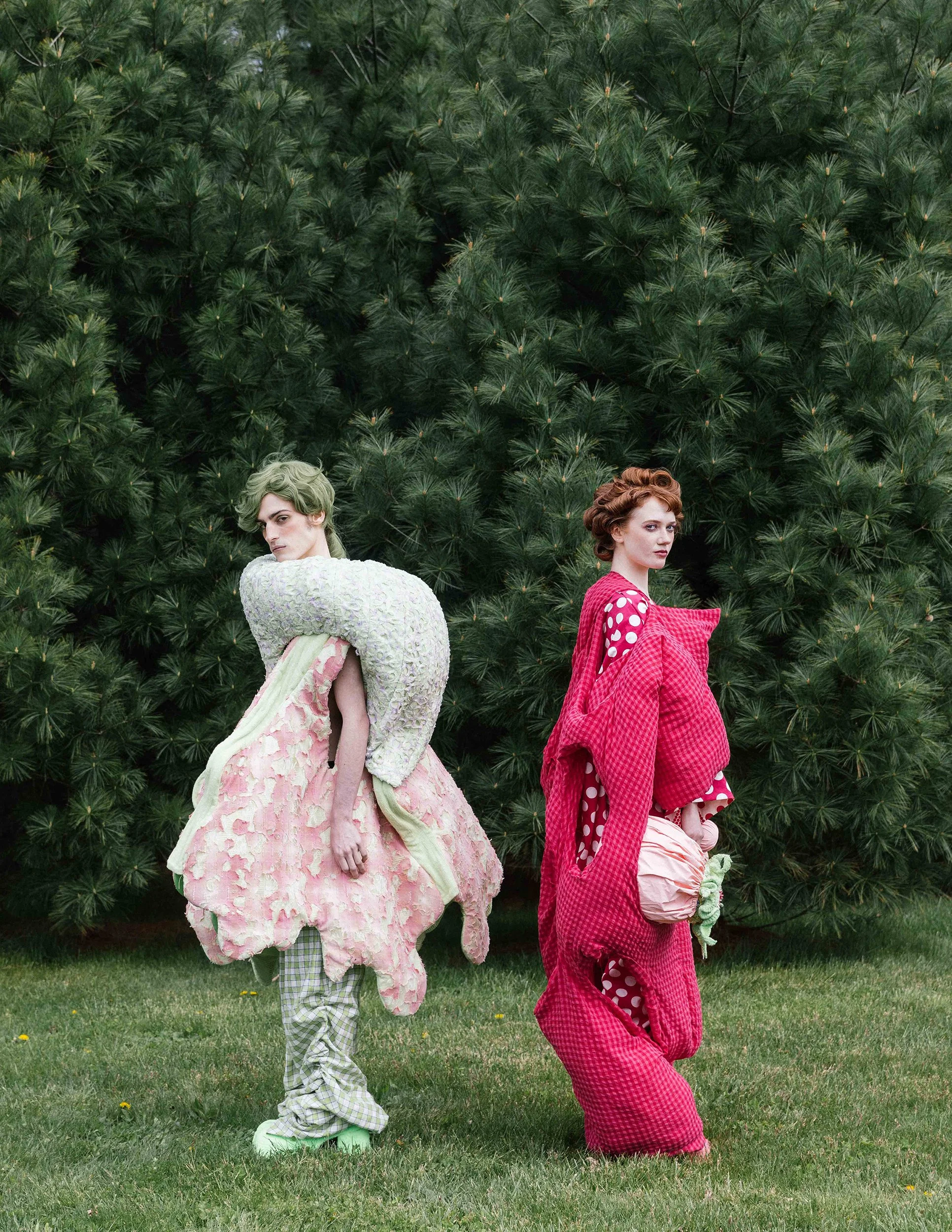10 Questions with Can Cui
Can Cui - Portrait
Can Cui, originally from Beijing and currently based in New York, is known for her sculptural silhouettes and thoughtful explorations of material. With a foundation in high-end fashion production, she has contributed to a wide range of notable projects for celebrities, including Doechii, Adrien Brody, Ariana Grande, Liu Yifei, Samuel L. Jackson, etc.
Her work combines technical precision with conceptual depth, often engaging with themes of identity, transformation, and emotional texture. Featured in publications such as Bazaar China, SELIN, and various online fashion and art platforms, Can continues to challenge conventional structures and explore the expressive possibilities of fashion through each collection and collaboration.
ARTIST STATEMENT
“As a fashion designer, I view garments not merely as clothing, but as emotional architectures — vessels that hold memory, movement, and identity. My work is rooted in an exploration of silhouettes and textile manipulation, often drawing inspiration from the tension between tradition and transformation. Having grown up in Beijing and now based in New York, I navigate a cultural in-between space, which informs my practice with layered perspectives on beauty, structure, and narrative.
I am particularly interested in how fabric can embody contradiction — softness with strength, elegance with distortion, control with chaos. Each collection begins with an emotion or a question, and unfolds through material experimentation, handcrafting, and draping, allowing intuitive processes to guide final forms. My recent contributions to celebrity projects, editorial features, and couture work continue to deepen my understanding of how fashion can serve as both personal expression and shared storytelling.
Through my designs, I aim to create wearable sculptures that are alive — garments that do not just dress the body, but speak to the soul.”
— Can Cui
[Chou Chou - bloom], yarn, cotton, linen, 2024 © Can Cui
INTERVIEW
How did you first get interested in fashion design, and when did you decide to turn your passion into a professional career?
I first became fascinated with fashion design when I discovered John Galliano's iconic runway shows for Dior, particularly his "Madama Butterfly" in 2007. I was captivated by the theatricality, dramatic silhouettes, and the way he transformed everyday environments into high fashion stages. As a child, I would drape bed sheets and bath towels over myself, trying to recreate the flowing, sculptural forms I saw on the runway. This early experimentation with fabric and form sparked my desire to pursue fashion seriously, leading me to study at Parsons School of Design, where I developed my technical skills and creative voice.
How has moving from Beijing to New York shaped your perspective on style, structure, and storytelling through fashion?
The move from Beijing to New York has been transformative for my design approach. Growing up in Beijing, I was surrounded by a culture rich in symbolism and tradition, where clothing often held deep cultural meaning. In contrast, New York exposed me to a fast-paced, boundary-pushing fashion scene that values individuality and raw expression. This cultural duality has deeply influenced my aesthetic, pushing me to blend structure with fluidity, tradition with modernity, and restraint with rebellion in my work. It has also given me a unique perspective on how garments can serve as bothpersonal armour and emotional expression.
[Chou Chou - bloom], yarn, cotton, linen, 2024 © Can Cui
Your work is known for sculptural silhouettes and fabric manipulation. Where do you usually begin when developing a new piece or collection?
I often start with a feeling or a question, something that lingers in my mind. From there, I move to fabric selection, as I believe the material itself often holds the key to a piece's final form. I drape, twist, and fold the fabric directly on a dress form, letting the material guide the silhouette. This hands-on approach allows me to capture the tension between chaos and control, softness and strength, which are recurring themes in my work. Sometimes, I even incorporate unexpected elements like industrial hardware or unconventional textiles to challenge the boundaries of traditional garment construction.
Many of your pieces explore contradictions, soft vs. strong, elegant vs. chaotic. How do you use textiles to express these tensions?
Textiles are my primary language for expressing these contradictions. For example, I might pair delicate silk with rigid metal boning, or layer transparent organza over structured wool to create visual and tactile tension. I am also fascinated by the way certain materials can age or degrade over time, adding an element of unpredictability to the garment's final form. These contrasts reflect the complex, often conflicting emotions I seek to capture in my designs.
[Chou Chou - bloom], yarn, cotton, linen, 2024 © Can Cui
[Chou Chou - bloom], yarn, cotton, linen, 2024 © Can Cui
You've worked with major figures in fashion and entertainment. How do these high-profile collaborations influence, challenge, or inspire your practice?
Collaborating with industry icons and celebrities has been both inspiring and challenging. These projects push me to think beyond my own aesthetic preferences and consider the client's personality, public image, and the context in which the garment will be seen. They also force me to innovate technically, as these pieces often have to balance extreme comfort, durability, and visual impact. At the same time, these collaborations reinforce my belief that fashion can be a powerful tool for storytelling and self-expression.
Do you approach celebrity commissions differently from your own artistic collections? Where do you find balance between personal voice and client needs?
Yes, my approach to celebrity commissions is more collaborative and context-driven. While my personal collections are deeply introspective, exploring themes of self-identity and emotional transformation, my celebrity work is often about amplifying the client's public persona while maintaining my own design language. The key is to find common ground where both voices can coexist, creating pieces that are both true to the wearer and authentic to my artistic vision.
What's your view on the current state of the fashion industry? Are there areas where change is most needed?
I believe the fashion industry is at a crossroads. While we are seeing more conversations around sustainability, diversity, and slow fashion, there is still a long way to go in terms of transparency and ethical production. I also think the industry needs to better support emerging designers, providing more platforms for experimental, concept-driven work rather than just commercial output.
[Chou Chou - bloom], yarn, cotton, linen, 2024 © Can Cui
Who or what in the fashion world today do you find exciting, whether designers, movements, or even shifts in consumer mindset?
I am particularly inspired by designers who challenge norms and blur the lines between fashion, art, and performance. Rei Kawakubo, Thom Browne, and Iris van Herpen come to mind. I also find the rise of digital fashion and virtual reality intriguing, as it opens up new possibilities for self-expression and garment construction.
Your work blurs the line between fashion and art. Are those two worlds becoming more connected or still too separate?
I believe the line between fashion and art is becoming increasingly fluid, as designers experiment with unconventional materials, conceptual narratives, and performance-based presentations. My own work often exists at this intersection, where garments become both wearable sculptures and personal totems. I hope to continue exploring this relationship, pushing fashion beyond mere functionality into the realm of emotional and conceptual storytelling.
Looking ahead, are there materials, ideas, or collaborations you're eager to explore in the next chapter of your practice?
I am eager to explore more sustainable materials, like biodegradable textiles and bioengineered fabrics, as well as unconventional forms of expression like digital couture and interactive installations. I also hope to collaborate with artists and technologists who share my interest in the intersection of fashion, identity, and technology.
Artist’s Talk
Al-Tiba9 Interviews is a promotional platform for artists to articulate their vision and engage them with our diverse readership through a published art dialogue. The artists are interviewed by Mohamed Benhadj, the founder & curator of Al-Tiba9, to highlight their artistic careers and introduce them to the international contemporary art scene across our vast network of museums, galleries, art professionals, art dealers, collectors, and art lovers across the globe.




















